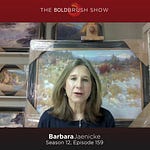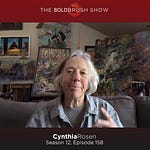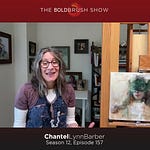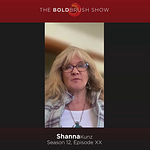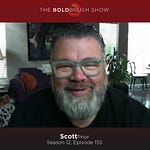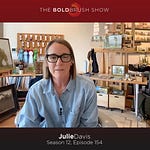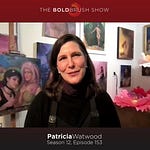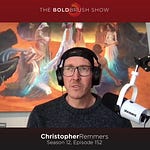Show Notes:
Learn the magic of marketing with us here at BoldBrush!
https://www.boldbrush.com/
Get over 50% off your first year on your artist website with FASO:
https://www.FASO.com/podcast/
Order your exclusive da Vinci BoldBrush paintbrush set!
https://brushoffer.com/collections/boldbrush
---
On today's episode we sat down with Ruth Fitton, a realist British portrait painter with a love of naturalist melacholic narrative painting. Ruth and I discuss her beginnings as a classical musician turned full-time artist, some key overlaps in terms of discipline between music and art, her greatest influences, and excellent advice for anyone seeking to improve at the craft of painting. We also talk about the importance of maintaining a clearly define social media page which allows the algorithm to better connect your work to the right viewers. She also emphasizes the importance of networking in person whenever possible as well as on social media. Finally, Ruth tells us about her exciting upcoming solo show at Panter and Hall in London!
Visit Ruth's FASO site:
https://www.ruthfitton.com/
Ruth's Instagram:
https://www.instagram.com/ruthfittonportraits/
Ruth's upcoming solo show:
https://www.ruthfitton.com/event/203996/solo-exhibition-at-panter-and-hall-gallery
---
Transcript:
Ruth Fitton: 0:00
Everyone understands immediately that you give a violin to an untaught person and it will require years of hard work for them to master all the techniques necessary to be able to play the Mendelssohn Violin Concerto. I definitely found that having studied music and learnt musical instruments since I was very small. I just expected that I would put in the same amount of practice and hard work into learning to paint as I did into mastering the violin and the piano, which are my instruments.
Laura Arango Baier: 0:35
And I think that helps me a lot. Welcome to the BoldBrush show, where we believe that fortune favors the bold brush. My name is Laura Arango Baier, and I'm your host. For those of you who are new to the podcast. We are a podcast covers art marketing techniques, and all sorts of business tips specifically to help artists learn to better sell their work. We interview artists at all stages of their careers, as well as others who are in careers tied to the art world in order to hear their advice and insights. On today's episode, we sat down with Ruth Fitton, a realist British portrait painter with a love of naturalist melancholic narrative painting. Ruth and I discuss her beginnings as a classical musician turned full time artist, some key overlaps in terms of discipline between music and art, for greatest influences, and some excellent advice for anyone seeking to improve at the craft of painting. We also talked about the importance of maintaining a clearly defined social media page, which allows the algorithms to better connect your work to the right viewers. She also emphasizes the importance of networking in person whenever possible, as well as on social media. Finally, Ruth tells us about her exciting upcoming solo show at Cantor in Hall in London. Welcome, Ruth to the BoldBrush show. How are you today? Thank you very much. It's good to be here. I'm doing great. Lovely, lovely. And, yes, we do have a bit of a time difference, which I love that about the podcast, being able to talk to, you know, artists from all over who have absolutely amazing work like yours. So I'm excited to have you on because honestly, I feel like you're one of the people I've seen who paints Absolutely. breathtakingly beautiful. And you didn't study at an academic school, which is so fascinating to me, because it's like me and I want to do achieved it. I could have saved myself like the six years of going to the schools.
Ruth Fitton: 2:28
Well, it's not it's, it's not without the pros and cons are definitely there. I think I missed out on having regular models sessions. For years, I would have, I would have given anything to have regular access to a live model. And also, I don't have the I didn't kind of grow up with the sense of community. And I ended up being very much on my own for a while. Now I'm making some more community connections, which is really nice. But it's definitely yeah, not without the the pros and also the cons. Yeah, that's understandable. And I mean, I did see that you do. I think you do like group sessions at your studio, which I think is really awesome. And that's, you know, how you're building community, which is great.
Laura Arango Baier: 3:17
But yeah, before we dive into all of that, do you mind telling us a bit about who you are and what you do?
Ruth Fitton: 3:24
Absolutely. Well, I'm, I consider myself to be a portrait painter. I've been painting for 11 years. I also do a lot of narrative work, and I'm doing sort of more more narrative work for galleries. And yeah, I just I love painting people and I love creating atmospheres. I go for a kind of naturalistic, aesthetic. But without unnecessary detail is one of the things I work for a lot. So
Laura Arango Baier: 3:59
I guess in a nutshell, that's, that's me. Yeah, yeah. And you know what, I really love that. You mentioned that naturalism, because your work definitely does have that sort of overcast kind of look to it, where it's an overcast day. And it's very posh. You know, it's very much that time period of painting, which I love, love posh. He's so wonderful. Yeah. Yeah. And then I'm peeking behind you and you have that little circular clock thing that you used in one of your paintings. Yes, I love that painting. I forget what it's called. But it's that old woman or old person holding the clock as if they were like, a lot of time. Oh, I love that painting.
Ruth Fitton: 4:43
Thank you. It's the abduction of time is the title. And yes, I often get asked whether I invented the clock from imagination. They say no, it was actually it was just a clock on the studio or
Laura Arango Baier: 4:55
so it's a working clock.
Ruth Fitton: 4:59
It's a working clock.
Laura Arango Baier: 5:00
Yes. Oh my gosh, I thought it was just like the front piece of like an old clock or something that got, you know, put in like an antique store or something. But it's really beautiful.
Ruth Fitton: 5:12
Thank Amazon. It's very inexpensive.
Laura Arango Baier: 5:17
It Yeah. And you're painting and looks like it's like some antique piece. I think you did great making it have that feeling. Yeah. Oh, that's awesome. So, you know, I wanted to ask you because you actually studied music, which I find fascinating as well. And like, with painting and art, music is actually a very solitary thing as well. So I wanted to ask you, how have you found any similarities between your studies and music and in painting?
Ruth Fitton: 5:49
Yes, there are definitely similarities between music and painting. They are generally not the similarities that people expect. I get a lot of people say to me, Oh, well, you've done both music and art. Clearly, you're super creative. But actually, the thing that really helps me, particularly becoming a self taught painter, was the fact that I had studied music previously, in terms of understanding the concept of constant practice and the discipline to do that constant practice. And I think there is, it's interesting if you if you speak to someone who is involved with the art world, or like an amateur artist, or someone who knows an amateur artist, they seem to think quite often that all you really need is talent, and a little bit of practice, and you're good to go. If you've got it, you've got it, right. Whereas no one would ever give a violin to either a child or an adult who had never learned to play it, and expect them to be able to produce the Mendelssohn Violin Concerto. Everyone understands immediately that you give a violin to an untaught person, and it will require years of hard work for them to master all the techniques necessary to be able to play the Mendelssohn Violin Concerto. And I think that's a really interesting contrast. But yes, I definitely found that having studied music and learnt musical instruments, since I was very small, I just expected that I would put in the same amount of practice and hard work into learning to paint as I did into mastering the violin and the piano, which are my instruments.
Laura Arango Baier: 7:51
And I think that helped me a lot. Yeah, yeah, I absolutely agree with you in that, you know, people seem to have this erroneous notion of, you know, oh, anyone can paint. You just grab, you know, paint and you put it on a canvas? No, no, I mean, you can maybe pull that off if you're doing something more modern or contemporary or abstract. Maybe, because even those practices still have their own rules and their own ways of doing things. I totally agree. It's, it's so funny how, you know, with music, it is absolutely a discipline, it's something that takes forever. And you know, not it's like how some people maybe they have like, perfect pitch, which can happen. But in the end, everyone has to train it. And I'm also of the belief that talent is, it's like it's mythical. It's like maybe one in like a billion people could say that they're absolutely talented. Whereas mostly it is discipline. It is sitting down and doing the work and doing the training and doing all of the basically the Doremi of painting, which you have to learn it. Yes, absolutely. Yeah. Yeah. So that actually leads me to a very interesting question, which is, why did you go from music into painting? Like, when was that moment when you were like, I want to paint I'm going to put on the violin for a second paint.
Ruth Fitton: 9:18
Well, it's not as exciting as as it might be. I had always been a creative child. I did all sorts of hobby things, picked up one crafty thing and tried it and then the next two weeks later, I was inspired by something else and I tried something else. So I started drawing faces when I was about 15. And I considered taking art for in in the UK, we have GCSEs, which are the exams you take when you're 16. But I decided not to take art and I took music instead. I thought I'll do one creative subject and I'll do all the rest in the proper subjects. And then at the same with the the exams you take when you're 18, continued with music, and then I opted to study music at university. But all the way through, I was actually spending probably more time than I should have been drawing and painting in acrylics. And then my first time at uni, we performed all the first years in the first term, did one big project. That's how it works every year at the uni I went to. And this particular year, we all got together and we performed a Bernstein musical called wonderful town. And one of the characters in that musical is an artist painting a portrait of one of the other characters. So the director who is in third year said to all of us first is, is there anyone here who can create a something that looks like a portrait of this girl so that we can use it as a prop for the show? So I said, Well, yeah, I'll have a go. And it was the first life size thing I'd done. And it was one of the first things I've done in paint rather than in pencil. And it was fairly horrendous. I actually, I had a message a couple of months ago from the girl who is in this portrait, and she sent me a picture of it, she's still got it, bless her heart, she's still got listening, I fainted 13 years ago, and it looks like a Disney princess. It's very exaggerated. And yes, it's not particularly subtle. But I did that. And then the next year, the Opera Society was performing an opera, which involved in the crazy world of opera plots, a painting a portrait of one of the characters falling off the wall and hitting one of the other characters on the head, which precluded this whole kind of dream sequence. And it was all very theatrical. So they knew I'd done the painting the previous year. And they asked me again, would you paint us a portrait of this person to use as a prop for opera? What are the chances of that happening? So I painted that one as well. And then after the show, the lead tenors mother approached me and said, I want you to paint a portrait of my son, I will pay you. So that was my first portrait commission. And then by the time I got to most of the way, through my degree, I've done various small commissions for friends on their parents. And it seemed unlikely that I would get my musical career wish of becoming a film score composer. So I chose the less, less, less difficult option becoming a portrait painting as you do. So I made that decision sort of partway through my final year at uni. And my parents bought my first ever oil paints as a gift for my 21st birthday. So I mark my painting anniversary is also my birthday.
Laura Arango Baier: 13:21
Yes, that was that was how it happened. Yeah, well, I think that was more exciting than you think. Because it almost feels like, you know, you fell into the path of least resistance for you. And it just like things just lined up, which doesn't always happen to people, you know, it's like, it's, it's such a balance of, you know, you hear the call, right? The call to like, become a painter. And you kept on with it, you know, despite you know, doing your music, but it's wonderful that you still kept on that path anyway, like it, I'll just keep doing it because I love it. You know, like, Yeah, some people they tell themselves or they hear from others, like, Oh, don't do that. That's a waste artists will make money, which of course is a lie. So it's great that you, you know, went on with it anyway. And I wanted to ask you, guys, what would you say are your greatest influences when it comes to your artwork?
Ruth Fitton: 14:21
Well, you've already mentioned one of them. You mentioned lavage. Apart and the other naturalists. Mostly I just find myself really drawn to that cloudy day outdoor lighting. I think it's probably partly because I grew up in Yorkshire in the north of England, where we have quite a lot of cloud a. I also love a couple of British painters who worked at a kind of similar time. Stanhope Forbes, is one of my favorites and a lesser known artist called Frank Bramley. Both of them work Seeing with a lot of outdoor scenes, a lot of overcast skies, and a very unfussy paint application which i i enjoy. I'm not a fan of really flamboyant and overdramatic paint work.
Laura Arango Baier: 15:18
Yeah, and definitely overcast does have that subtle softness. You know that you and it's actually quite colorful a lot of people would think that it's very pale but it's not it, it can be actually quite colorful to be able to see all the little subtle tones that sometimes direct light can wash out completely. Especially. Yeah. So speaking of because I think, you know, especially you mentioning the violin, I find that the violin, in my opinion is very melancholic instrument. And I also find that your work does have a bit of a melancholic air to it. What are some of the topics that inspire you to paint? Well,
Ruth Fitton: 16:03
on a personal level, I think I connect a lot with themes of courage, and resilience. So I guess the the kind of melancholic air comes from me placing characters, perhaps in situations of adversity on some level, I like the idea of staying strong in in adversity. And I think that comes through quite a lot in what I'm painting. The the main thing that I'm going for really is, obviously, I'm aware that I'm painting in quite a classical fashion with quite it. It harks back to olden time paintings in various ways. But the one thing that I'm really trying to bring is, I want my female characters to actually be characters. And I say this quite a lot. It honestly amazes me that there are still, in this day and age, there are a lot of painters, wonderful, wonderful contemporary painters, of both male and female, who will still paint pictures of beautiful landscapes with beautiful women just standing there, inside profile, looking slightly down, or looking slightly up, or even from the back of the head. And they have no motivations of their own. They have no discernible story, apart from the fact that they're standing there looking beautiful, being a compositional focus in a beautiful work of art. And
Laura Arango Baier: 17:50
I
Ruth Fitton: 17:54
could not paint something like that. It just, it doesn't sit right with me. And so I spend a lot of time thinking and planning and thinking. Whenever I start a painting, it has to have a story even if the story itself is not massively obvious by the time the painting is completed. As long as I know, there has been a narrative and that the character I'm portraying has, in my intention, motivations and emotions that I'm happy, and I actually get every now and then I will get a message from another artist, usually a female saying, I really, really love the way you make your women into people. And I mean, that's not the only reason I paint and it's not my only focus, but it's
Laura Arango Baier: 18:54
Yeah, I guess, is one of the things I choose to do with what I'm doing. Yeah, at BoldBrush we inspire artists to inspire the world, because creating art creates magic, and the world is currently in desperate need of magic. BoldBrush provides artists with free art marketing, creativity, and business ideas and information. This show is an example. We also offer written resources, articles and a free monthly art contest open to all visual artists. We believe that fortune favors the bold brush. And if you believe that to sign up completely free at BoldBrushshow.com. That's BOLDBRUSH show.com. The BoldBrush Show is sponsored by FASO. Now more than ever, it's crucial to have a website when you're an artist, especially if you want to be a professional in your career. Thankfully, with our special link facile.com forward slash podcast, you can make that come true and also get over 50% off your first year on your artists website. Yes, that's basically the price of 12 lattes in one year. which I think is a really great deal considering that you get sleek and beautiful website templates that are also mobile friendly e commerce print on demand in certain countries, as well as access to our marketing center that has our brand new art marketing calendar. And the art marketing calendar is something that you won't get with our competitor. The art marketing calendar gives you day by day, step by step guides on what you should be doing today, right now in order to get your artwork out there and seen by the right eyes so that you can make more sales this year. So if you want to change your life and actually meet your sales goal this year, then start now by going to our special link faso.com forward slash podcast. That's FASO.com/podcast. I love that because I completely agree with you. I feel like historically, actually, even paintings from Renaissance have character, you know, women with more character than some of the prettier sort of objectifying objectified presence of a woman in a painting today, you know, like, I completely agree that it is boring for me, it's so funny, because I'll have this discussion with guy friends. They'll see a painting of this beautiful woman, and she's like sleeping, or she's like laying down. I'm like, This is so boring. I mean, she's not adding anything interesting into my psyche. And I don't I don't see what she's going through. I don't, I can't relate to it. Because no, and oftentimes, it does happen with, unfortunately, with male painters. And I totally get it. I mean, they don't know what it's like to be a woman. But yeah, it is a bit boring and a bit overplayed to have the pretty young woman who's, you know, the reclining nude or something, you know, like, it's been done 1000 times over, and it's fine. But I do agree that adding a little bit more of narrative a little bit more story. Little bit more of the, I guess the more fascinating archetypes of being a woman, you know, kind of like how Kathy Cole was, you know, with her, the mother sort of archetype that she paints again and again and draws again. And again. I love that I think that is, you know, it takes things to a much further level than just decorative female. But you know, there are people for everything. I'm not hating on decorative female paintings, I'm just saying they're not my preference, either. Because there's more, there's a lot more to life than just hearing you. So I totally agree with you. I wanted to ask you now, what is like the number one tip because you're primarily self taught, right? You sat down and you painted, you did not attend academic school, which takes a lot of discipline to reach the level that you've reached, which is insane. I, I completely like you inspire me. So I wanted to ask on behalf, you're welcome on behalf of painters who maybe are in a similar position as you where maybe they can't go to an academic school, or maybe they don't have access to that. What is the number one tip for them to improve at their craft. My number one tip for improving artists, is
Ruth Fitton: 23:09
practice with intention. I think this is very easy to fall into the habit of just doing the same thing over and over, and thinking, oh, you know, just have to keep going. And consequently making the same mistakes over and over without really thinking about it until they're absolutely ingrained. That would be one tip. And my other tip is don't be too hard on yourself. Because conversely, I have seen and I know many great painters, sort of my peers, my similar age to myself, who are doing great work. And I see them tearing themselves down, because their standards are so high, and the place they want to get to is so high and lofty. And I don't think that is that's not a good headspace to be in it's not going to be productive for you actually improving. It's just going to make you miserable and make your friends miserable. So yeah, that is that was actually my my more genuine tip is obviously practice, obviously strive to get better, obviously do lots of research. But also be happy with where you are and be happy with what you are producing. And don't always ignore how good you're getting. Because you're too obsessed with how good you want to be. Words of Wisdom. Oh my gosh, that is so true. It is so easy. Yeah, it's so easy to fall into that trap of you know
Laura Arango Baier: 25:00
My goal is over there and you forget that you know, where you're standing is already quite a feat, right? It's, it's so great to look back at maybe like your first painting or, you know, the first times that you attempt at something and then comparing that to so much. Yeah, which actually, what you mentioned reminded me so much of music. Because, you know, the practicing with intention, right, I find that when I watch musicians practice, they have this tendency, if they reach a very complex part of a piece, they'll repeat it, maybe a little slower. And then they'll go through it again and again, until they can move past that problem. Which, I mean, it should be the same with painting, right? We also like there's so many similarities in that sense, where we have the skills and we have those, those hard moments where you have to slow down and I think a lot of people are so you know, the instant gratification of I gotta finish this fast, and I gotta move through this. And there's, I'm running out of time, which I mean, I get that life is short, but it's okay to slow down and really sit through those issues. And that, yeah, just digest them a bit longer to get past them, then rather than just okay, I did it. It's yeah, I'm unsatisfied. It's like, Are you are you satisfied?
Ruth Fitton: 26:22
Yes. Yeah.
Laura Arango Baier: 26:25
So now I'm kind of curious about the marketing side and the social media side. Do you have any social media tips for an artist who is looking to get their work seen more, like by potential buyers, or students or collectors or maybe galleries?
Ruth Fitton: 26:44
Well, social media for me is Instagram, basically, I don't do Facebook. So I have a couple of tips, which I guess maybe people know or don't know, that I have picked up from discussions with other friends who are also trying to use Instagram effectively. And the main tip is that it helps if you have a niche, not just with your art, but with what you are presenting on Instagram. So if you are a portrait painter, don't suddenly start interspersing your portrait straight images with the landscapes. And the Instagram algorithm is not going to like that. And it does have a tendency to penalize you beyond one individual post, if it doesn't like what you've done. So I have friends who will have a page for their portrait work a page for their teaching work and a page for their nude figures, in particular, do not mix your nude figures in with the rest of your page, because Instagram really, really doesn't like them. And you don't want the entirety of your output penalized and hidden from everybody, because you've got some nude figures in there. So put your new figures all in one page. And then if Instagram wants to hide that page, it's only hidden a percentage of your work rather than all of it.
Laura Arango Baier: 28:11
It's so smart. I didn't think about that. Because it does tend to happen, especially with academic painters. Instagram, you know, Shadow banned some for I don't know how long just because they posted a realist painting of a nude, which is, you know, not a real nude. It's painting. It's artistic. But, you know, they're like, nope, nope. So it's good to have that. Because then you know, like you said, maybe you have a crowd who can also follow, you know, just your portraits or just your landscapes, or just your teaching page, which it really helps compartmentalize, like you said, Really, yeah, bring more of a focus to the algorithm to, you know, expedite your workout to the right people, which is great. Yeah.
Ruth Fitton: 28:59
And also, if your Instagram is one of your main landing pages for anyone who, you know, rather than going to your website, often these days, people will just go straight to Instagram. So it helps to properly curate your page. So a similar thing, it's good to have things unified. I find my page gets the most response when I have mostly all kind of close ups of faces. So it looks like it's like a shop window or a store window as you'll stay in the States. If everything if everything in a in a display matches, it's like eye candy, like if I was recently at the portrait Society of America show and in the materials Hall, you've got Michael Harding with this array of painting all these boxes in all different colors, but they're all arrayed in the same way. And there's Rosemary brushes with all their different brushes. If you took everyone's stools and jumbled them all up, it would just be a mess. But as it is, you'd go from one to the next. And it's just as eyecandy have all their similar things displayed together. So yeah, you have to do the same with your Instagram page. It's your store window, you have to make it so that it all matches and harmonizes and is exciting and delicious to look at.
Laura Arango Baier: 30:25
I like that description delicious to look at. Feels like a pastry shop. Yeah, absolutely. Yeah, your Instagram should be on pastry shop. Yeah, I love that. Um, you know, yeah. And it's also good to have, obviously, to still have a website anyway. Because you know, that way that people were very interested in just, they could just pop in, and then they'll see the rest of your work. And then they'll sign up for your newsletter. And then they have more of an opportunity of, I guess, getting more of an intimate sort of look into what you do who you are, maybe if you have a blog, which is really nice.
Ruth Fitton: 31:00
Absolutely. And I find that the, the people who are more serious will go from my Instagram to my website. So if I get an inquiry through my website, I will take it much more seriously than all the DMS I get on Instagram, most of which are spam. So yeah, it's definitely is like Instagram is the front of the shop. And the website is the actual shop. Where all the good stuff? Yes, exactly. No people asking for NF t's on your website. It's just on Instagram. No.
Laura Arango Baier: 31:33
Exactly. Um, so this is one question that I like to ask basically everyone that I interview, which is, you know, the side of how, like, do you have you had to keep a day job while you paint? Or have you been able to live off your paintings?
Ruth Fitton: 31:53
It's a very short answer. I've never had a job other than painting. Yeah, that's great. I have a couple of I've had several very slim years. But yes, I've never, never taken on a different job.
Laura Arango Baier: 32:10
That's awesome. Yeah. So that makes it a lot easier to free to balance your time with painting and, and spend time, you know, doing what you love, which is very fortunate. I know, a lot of people who they worked their day job for years and years until, you know, their work took off, which is why I like to ask, you know, there are so many different ways that artists have been able to move past things and have been able to, you know, make their money with their work. So it's good to have a bit of a, I guess, an understanding from different artists about their own paths, because for some people might be one way for others might be like your path. That's awesome. Yeah. And then, so I wanted to ask you, because you are part of a lot of different societies, right? You're part of the oil painters of America, I think you're also part of the royal portrait. What is it? Yeah, Royal Royal Institute of loyalty?
Ruth Fitton: 33:08
Yeah, I'm okay. So I am actually only a member of the Royal Institute of modern painters. And I have signature status membership with the portrait Society of America. I don't think I've ever I've never exhibited with oil painters of America actually. Okay, but I should look into. And, yes, I have exhibited with the Royal Portrait society here in the UK as well, but I'm not a member with them. Gotcha. That's awesome, though. Because I find that you know, what I wanted to ask you is,
Laura Arango Baier: 33:43
do you think that those are really really awesome ways to network and to meet others? And would you recommend for artists to join societies like those?
Ruth Fitton: 33:54
I absolutely would. Yeah, so the the societies I am, like, have membership with that I mentioned, that's not something you pay for, that's something that you get elected into. So you can't just decide I'm going to sign up for membership. However, whether it's a society like portrait, a society that has a paid membership section, or whether it's just applying to exhibit with a society, like the ROI, a lot of painters or the RP, to our society of portrait painters. If you get into the show, obviously, you go to the private view, and that's where you meet all the other artists who are exhibiting. So I think that's certainly if you're based in the UK, I think those those shows are really good to enter for or even if you're not in the UK and are able to make the trip to London if you get selected for the exhibition. It's yeah, I mean, it's so fantastic. To experience you, all the artists have their their work is on the wall, you can literally walk up to a person's painting and talk with them about their work with an example of it right there. And you can go along even if you're if you get someone to take you as their plus one.
Laura Arango Baier: 35:16
You can go along even if you're not an exhibitor, and yeah, they tend to be really fun. Events. Nice. Yeah, it seems like it. It seems like it's, you know, a great way to meet maybe other artists who are maybe close to or close by to you and then learn from them. Or even I have heard others who have said that that's how they've met their galleries as well and how they've connected in that way. Are there other ways that you would suggest for artists to network? I would suggest,
Ruth Fitton: 35:48
I think one of the best ways to network is actually to take workshops. So sign up for a workshop with your favorite artists. And you'll not only get to meet your favorite artists, but you get to meet half a dozen a dozen people who are also learning to paint who also love that artist. I mean, it's a fantastic, it's a ready made networking opportunity, really. As well as things like the portrait Society of America conference, or, I mean, I've never been to the other conferences in the States, but I would really like to sometime the plein air convention, that kind of thing. Yeah, I just think if you can actually get people together in person, that is the best way to network? Definitely.
Laura Arango Baier: 36:36
Yes, yes. And actually, I think also social media, for those who can't really travel very much. Because it does seem like you know, social media at least connects you with, you know, people who might also go to those conventions, and might also go to those, you know, places. Yes. Yeah. Yeah. And also, I wanted you to mention more about your teaching, because I feel like you do take online mentorships like, do you teach others online?
Ruth Fitton: 37:07
I don't, I get asked all the time, whether I teach online. At the moment, I have not had the time to sort it out. I mean, I follow a couple of people. People's Patreon isn't that kind of thing. I'm not currently, but I have done previously. And the time and effort that goes into actually producing a quality product, combined with the fact that I don't currently have WiFi in my studio. That's not ideal. So I'm not offering online teaching at the moment. I'm taking. I'm teaching a couple of workshops this year, in person ones. I'm teaching one with artists in Italy next week. And I'm teaching one in Seville with La Galleria rocker in October.
Laura Arango Baier: 38:01
That's so exciting. Oh, that's awesome. I totally Yes, I know. Yeah. Yeah. And I totally understand not having time, I'm sure you probably have Commission's to take care of and your own personal work that you want to take care of. And then also, you know, going to these workshops that you're teaching and preparing for those, it is quite a lot on your plates. I guess one final question for you. Because now that you mentioned, you know, being a bit busy, how have you found yourself to be able to time manage a little bit
Ruth Fitton: 38:40
that's the kind of assume is that I am successfully time managing at the moment. I'm not entirely sure that I am. I, I try and paint nine to five, five days a week. Sometimes I do six days a week because I go to other. I go to portrait group that's hosted by a friend here in London. I'm actually no longer hosting my own group since I moved from my lead studio to London, because there are groups here already. So I'm taking your break from hosting and I'm doing the droppin thing, which is great. So timing, yes. This means that basically I do admin in the evenings and at the weekends. So I'm working pretty much around the clock. I work and I keep house for myself. And that's pretty much the extent of my life at the moment. Wow. Yeah, but you still sound busy. I mean, nine to five. That's a lot of time paging. That's a full time job, which is
Laura Arango Baier: 39:47
Oh, yeah, I would kill to have that time. But yeah, so actually, I wanted to ask you about your upcoming solo show.
Ruth Fitton: 40:01
Yes, well, thank you. I have an upcoming solo show. I have a show in London in July, with a gallery called Panther and Hall, who I've been running for 25 years or more. And they're a wonderful gallery wonderful people. They have a gallery on pound mount, which is right in the centre of London, it's kind of, if you go along Palomar, you reach the National Gallery. So it's, it's a wonderful, wonderful spot. And there are 19 paintings in the show. Most of them are figuring landscape works with, I think, six small plein air landscapes as well. So 13, figurative and six landscapes. So it's, yeah, it was kind of put together in a quite intense period of time, probably about seven or eight months. And having done all the planning prior to that, so it was just literally brushed a canvas. And it was very exciting. Actually, I found myself doing a lot of work that I was really happy with. And you have reached reaching new heights, if I may say so. Yes, I permitted myself to say that I'm reaching new heights, I am allowed to say that. Yeah, absolutely. So yeah, I'm really pleased with the work that's going up there. And it's all, as we were talking about is all very narrative. And it's all kind of loosely based around the theme of journeying with thinking about this both allows me to place the figures in landscapes, which I love, and also a physical journey can be a metaphor for a mental journey. So yeah, obviously, that means the paintings have a, you know, a wider relevance than just being literal stories of people wandering in fields, for example.
Laura Arango Baier: 42:14
Yeah. Oh, that's so exciting. I wish I could go. Yes. Well, I will do an Instagram live on the day we open. Oh, my gosh, yeah, show everyone round. Yes, I'll put a reminder for that, because I really want to see that. I'm also a big fan of your work. So it's, it would be so nice to go and be like, you're welcome. But yeah, Is there anywhere else that you have your work that people can go check it out.
Ruth Fitton: 42:48
I have a couple of pieces in the salmagundi club for the Hartley Invitational exhibition, which I think is up until the 31st of this month. So anyone in the New York area can go and see a couple of small works there, along with a lot of other very sensational works. I was very intimidated when they published the list of exhibiting artists, after I had already, you know, painted and framed up and then obviously, I had a complete meltdown. When I saw who was going to be involved in this exhibition. Yes, obviously, I did my best work anyway. But yes, I think there's always if I knew that I was going to be exhibiting amidst the company that I was, I think I would have found it within myself to magic have an extra gear to go into? Or maybe not. Maybe I would have just made myself really stressed. I don't know. Maybe it's just as well. Yeah. Yeah, maybe.
Laura Arango Baier: 43:46
But yeah, and then your social media and website.
Ruth Fitton: 43:52
Yeah, my social media Instagram is Ruth fitting portraits. and my website is just Ruth in.com.
Laura Arango Baier: 44:00
Awesome. Well, thank you so much, Ruth, for giving us some of your time, your precious time, considering you're probably busy trying to prepare for your soul. And thank you for your tips. I am definitely inspired to be a lot more disciplined with painting. So thank you.
Ruth Fitton: 44:21
Oh, thank you. It's been fun. I've enjoyed it. Yes, so glad.



